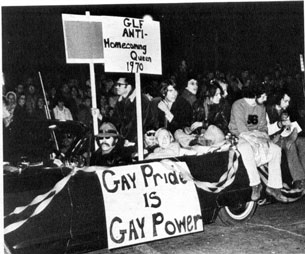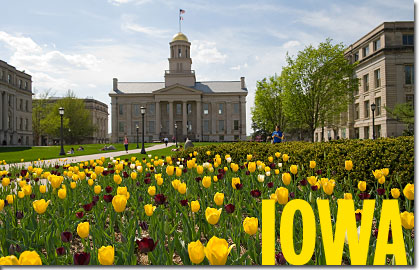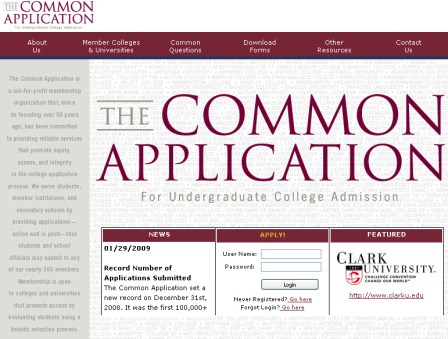When it comes to gay rights in higher education, the University of Iowa has been on the front lines for decades. In 1970, they became the first state university to officially recognize a GLBT group on campus, and they’ve offered insurance benefits for domestic partners of employees since 1993, longer than any other American public university. This week, the Hawkeyes put another notch in their rainbow belt when they announced that they have added an optional question on sexual orientation to their undergraduate application. The question, which asks prospective students “Do you identify with the LGBTQ community?” will appear in a section that also includes optional inquiries about parental education levels and interest in on-campus groups such as fraternities and the ROTC. The University of Iowa is the first public higher education institution to specifically ask about queer identity; Elmhurst College, a small private college in Illinois, added a similar question last year. The University of Iowa also added a “transgender” option to their gender identity question.
These ideas were proposed by Jake Christensen, a senior admissions officer. Christensen is gay and an alum, and says that, as a student, he always found the U of I community open and accepting – so much so that when he began working in the admissions office, he was surprised to find no “targeted recruitment” of LGBTQ students. With the new question, Christensen and his cohorts hope to send a message of support and acceptance right out of the gate, connect prospective students with appropriate resources, and include LGBTQ students in demographic studies. Answers will not factor into admissions decisions.

In fact, the answers might not matter as much as the question itself. School officials think the question’s very presence will say something about what the school stands for. “For some students, this may be the first time in their lives that an institution has exhibited a sensitivity to diversity, and has sent a welcoming message,” Christensen explains. The university’s Chief Diversity Officer and Associate Vice President Georgina Dodge agrees, saying that “asking LGBTQ students to identify themselves demonstrates that we value this aspect of identity just as we value the other categories for which students check boxes.” Michael Barron, the Assistant Provost for Enrollment Management, thinks the question “will cause [queer students] to look more closely at the university because we value that part of who they are. We want students to feel we are receptive to and sensitive to their lifestyle and their description of themselves.” Meanwhile, even if the question doesn’t affect them, the fact that the application asks it tells straight kids what kind of a university they’re dealing with. “We are telling people that this is a place with respect for all kinds of students.”
In addition, the new question will be used to help the University direct students towards resources they otherwise may not have found as quickly. “What we’ve heard from students, especially LGBT students, is that they don’t find out about support services and organizations until they’ve been here for a year or two, unfortunately,” says Dodge. “This [new question] allows us to do some more personal outreach.” It will also provide them with demographic information that helps them figure out to what extent the school is “attracting applications, admitting, enrolling or graduating students of differing sexual orientations or gender identities.” Data like this could help the school better allocate its resources and apply for grants.

The school’s current gay population strongly supports the measure, as does Campus Pride, a nonprofit that, among other things, rates the LGBT-friendliness of colleges and universities in an Index available online (the Department of Probably-Not-Coincidences reports that Christensen is quite involved with Campus Pride, which gave the University of Iowa a near-perfect score in 2011. One of the only areas that needed improvement? “LGBT Recruitment and Retention Efforts”). “For the first time, a major, public and national research university has taken efforts to identify their LGBT students from the very first moment those students have official contact with them,” says Campus Pride executive director Shane Windmeyer. “This is a huge deal in that it shows any campus that it can do the same thing.”
In January 2011, Windmeyer tried hard to get more campuses to do the same thing when he spearheaded a petition asking the Common Application to add a similar question to their undergraduate form. The Common Application, which serves as the gateway to nearly 500 member schools, voted down the proposal, citing fears that the question might make students uncomfortable for a variety of reasons: “Would the student feel pressure to answer? Would the student worry how this information would be used? Would the student worry who had access to this information? Would the student worry that a negative decision was in part because of their answer?” Rob Killion, the Common Application’s executive director, also points out that the Common App already asks students if they’ve been involved with gay rights organizations in high school, which provides colleges and universities with another way to “identify applicants who may benefit from targeted outreach efforts.” The board plans to revisit the proposal sometime in the next decade (I’ll bet it’s sooner, now that the University of Iowa has made its move).

The other notable change in the U of I application, and one that’s been getting skimmed over by most of the press coverage I’ve seen, aims to make the gender identity question more inclusive. It’s a good idea that fell apart in the execution: the drop-down menu that used to ask applicants to choose between “male” and “female” now includes a “transgender” option. This doesn’t make much sense; many people who identify as trans still consider themselves male or female, and, although a list that tried to hold all possible gender definitions would stretch far beyond even the largest computer screen, “transgender” seems like a less-than-adequate catchall. I’m surprised they didn’t follow the recommendations of the Consortium of Higher Education LGBT Resource Professionals, which recommended the following to the Common Application board in early 2010, after consulting with consortium members, “other professionals who work in higher education (e.g., director of financial aid, visa specialist, professor of trans theory), [and] transgender activists outside of higher education”:
“Our primary and preferred recommendation… was that the gender question should mirror the question about ethnicity. Making the questions parallel would make the question about gender optional and students would have the ability to select more than one option. The language we suggested for applicants to be able to select is:__female__male__transgender__additional identity (specify_______).We did not want to “other” the transgender identity, and we also wanted to leave the ability for applicants to be able to select more than one option and write in a different or more specific identity. The “specify with a line” language is consistent with the language on the question about ethnicity.”
Sarah Dopp, who runs a genderqueer blog AND a tech blog, provides some even more nuanced options (I particularly like the gender-spectrum slider bar).
Is the University of Iowa’s idea a good one? And what exactly will it do? The shift from high school to college is a particularly tricky one for queer adolescents. Although many more kids are now coming out in high school, many still wait until college, and others test the waters a bit before they do that. Those who are waiting until college to come out may do so for reasons that would also make them wary about, say, getting an LGBT-themed brochure in their school mailbox, or telling their parents about receiving a diversity scholarship. Others might not be comfortable with labels (something that Christensen took into account when he was wording the University of Iowa’s question). As high school guidance counselor Susan Tree puts it, “Not everybody shares the same context for this question. For some kids, this would be extremely affirming, and for others, this would be very intimidating.” Even if being in a supportive environment brings a kid right out of his shell and/or the closet, it can be hard to imagine and act on that feeling before you actually get there, even with bolstered faith from a particularly welcoming application. This fact has already affected the school’s first-year housing program: Spectrum House, “a living-learning community dedicated to promoting inclusion and awareness for individuals across the gender and sexuality spectrum,” will be incorporated into a broader social justice living-learning community next year. “Spectrum House has struggled for numbers since it was created in 2011. The main reason for this is many first year students are not yet at the point to select Spectrum House – but would be more interested in something similar that does not “out” them at the same time,” Kate Fitzgerald, the University’s Director of Residence Life, told me. Whether this new application question will help first years get closer to that point remains to be seen.







